What's a "bee block," you say?
It's a hand-made habitat hotel for native bees, of course.
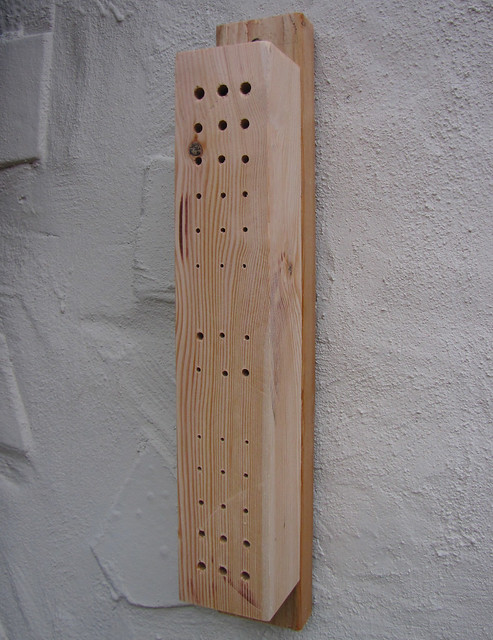
My new bee block on the wall right after I hung it
You see, many of the native bees in CA use such small holes in wood or soil for their nests and overwintering egg chambers. The classic big black California Carpenter bees that over-love our patio posts and rafters being the most well-known, I expect.
My block saw very little use the first season. But, by season 2, the native bees had found it, and started moving in. I've seen several species on and around the block so far, but the most common residents, and the least camera shy, are the too-cute little leafcutter bees.
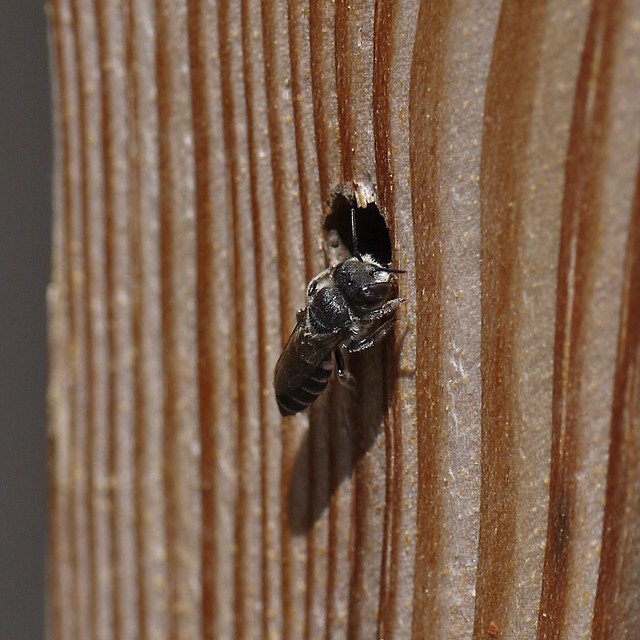
Leafcutter bee, likely Megachile brevis, the Short Leafcutter, chillin' by her hole

Leafcutters working hard on Labor Day to finish up their nests

One taking a break after collecting pollen to prime her nest's cells
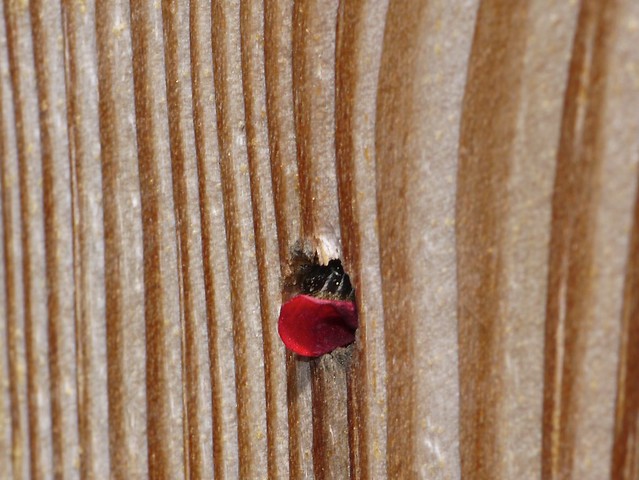
Another bringing in a flower petal to line the walls of the cells

Capping a nest
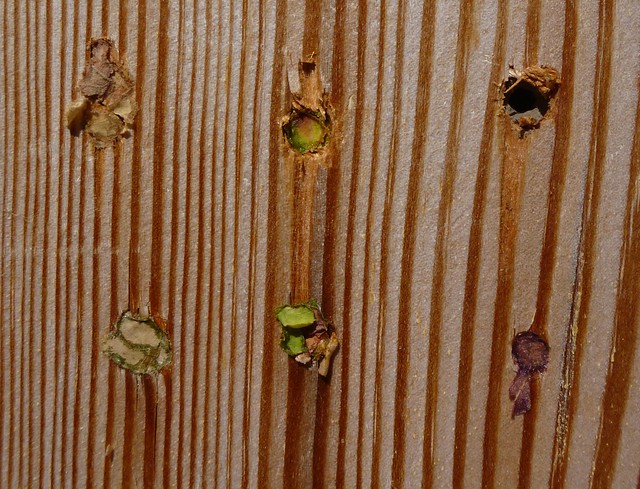
Six capped nests showing leaves, petals and mud as building materials
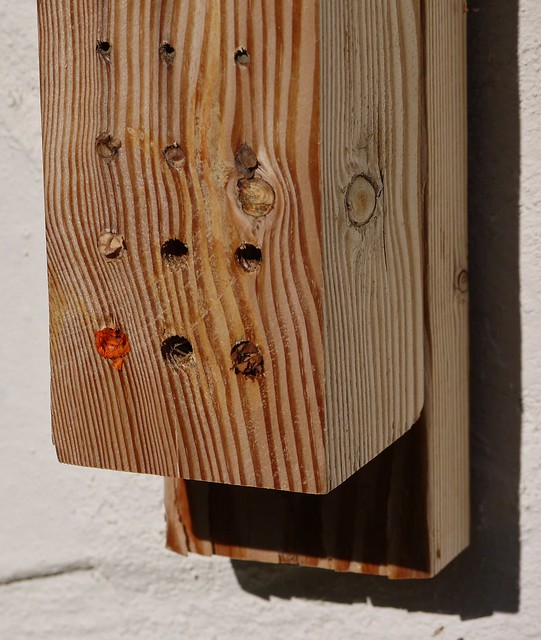
Some even like colorful caps, such as this one made from Cal poppy petals
Now, as we near the end of season 3, the block is pretty much full.
And not because I've kept mortgage rates low. It's full up because successive generations of bees generally come back to where they were born to build their own nests.
However, the bees aren't the only visitors to the block. As with most animal species, where there's herbivores, there's carnivores. In this case, parasitic wasps...
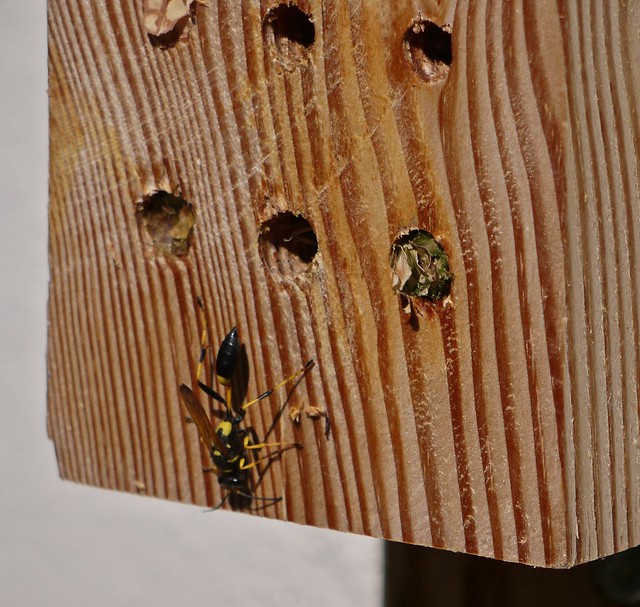
A Black and Yellow Mud Dauber hunting for spiders to parasitize for her children
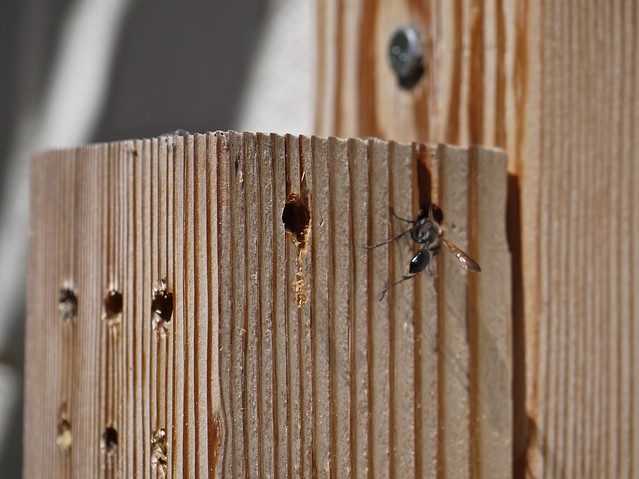
And another spider hunter sniffing around

A tiny Torymid Wasp, likely Torymus californicus, looking for oak gall wasp galls to parasitize (I have 2 small oak trees in my backyard too)
But, the most interesting visitor to the block by far has been Lady Leuco - a parasitic Leucospidid wasp that is commonly associated with Megachile brevis. I.e, the cheetah to the gazelle.
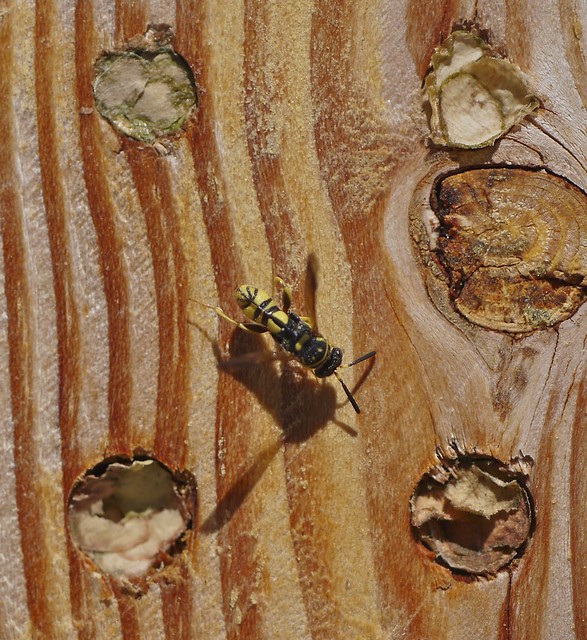
Leucospidid Wasp, likely Leucospis affinis, sniffing around the block
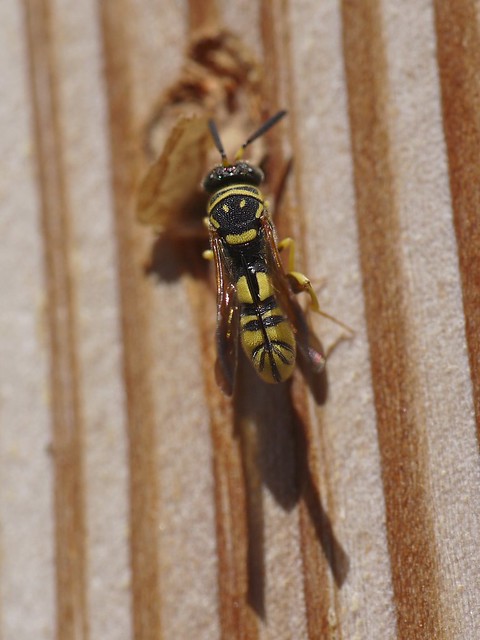
Looks a lot like a yellow-jacket, huh? She's a mimic. She even flies like a hornet in that zig-zaggy back-and-forth manner. But, she's about 2/3 the size, and has no stinger - her collapsible backside is just full of ovipositor and eggs
Nicely, her repeated returns allowed me to bust out my macro lens for a few rounds. Nothing like the masters at Beetles in The Bush, but definitely some of my best of such a small subject.
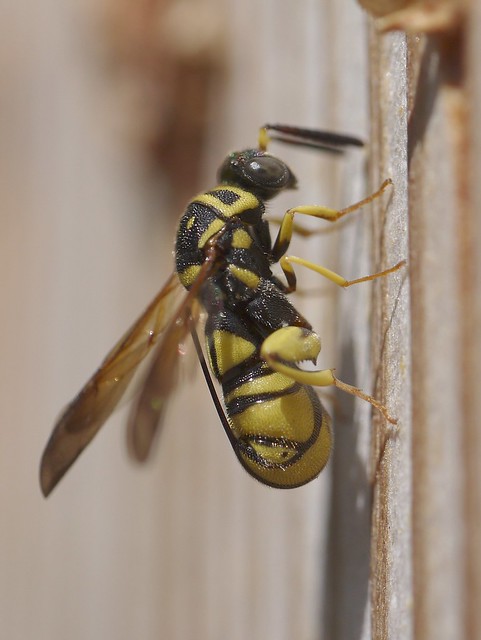
Lady Leuco sniffing for full leafcutter bee nests. When she finds a spot she likes, she drums her butt on the wood to precisely echolocate a cell
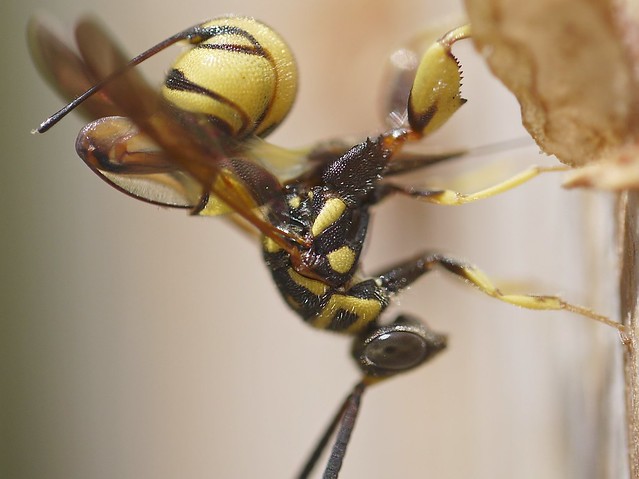
Macro shot of the junk in her trunk as she unfolds it to drill

Ovipositing her eggs into the leafcutter bee egg chamber. It's amazing how easily she's able to push that needle (her ovipositor) through the wood
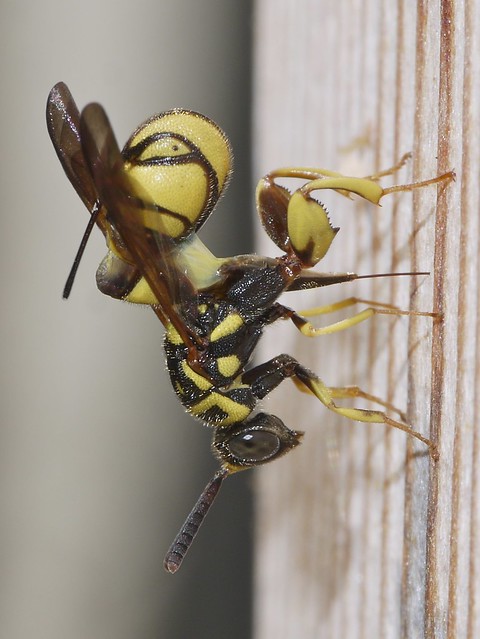
Drill baby, drill! A terrific aspect of these Lady Leucos - once they're ovipositing, they'll sit still and let you stick your lens all up in their face
Now, some might say that by creating such a focal point, I could be hurting the native bees by allowing them to be parasitized more easily. But, I'm dubious of that. The evidence just doesn't seem to support the idea. I see many more leafcutter bees in my backyard than I did pre-block. I.e., I think the increase in leafcutter proclivity from having access to ideal egg-chambering habitat is outpacing any parasitism. Probable reasons why:
- leafcutter bees produce multiple generations per year
- a chamber can have multiple cells, back-to-front, with an egg in each
- the first thing the hatched Leucospis larva does is kill any other Leuco larva or eggs in the cell to eliminate the competition
- each Leuco larva only parasitizes 1 leafcutter larva
Making a bee block is easy, btw. If your kids are aspiring nature geeks, or you just want to support and observe some cool native bees+, you might want to give one a go. Get a chunk of wood, drill some holes into it, and mount it solidly in a sunny spot. Don't use redwood - a lot of bees don't like it. I used a fir 4x4, but natural logs work great, too. You can drill various sized holes to attract different kinds of bees - I ranged from 1/8" to 5/16" and kept them all roughly 2" deep. Just don't drill through the wood, or they'll have to plug both ends.
Btw - supporting native bees is great for the garden, too. Especially if you grow any native wildflowers. European honey bees don't like/know all of our native flora, so the native bees help cover the gaps and can increase fruiting and the reseeding of annuals.
Oh - and the sweet little Megachile leafcutters seem to prefer the 3/16" holes. :)
====
References:
- Charles Duncan Michener - The Social Behavior of Bees: A Comparative Study
- Charles Duncan Michener - The Biology of Leafcutter Bees
- Jerry A. Powell and Charles L. Hogue - California Insects
- BugGuide - Megachile brevis
- BugGuide - Leucospis affinis
- Earthlife.net - An Introduction to the Solitary Bees
- Wikipedia - Leucospidae

I think you deserve a Pulitzer for this one. What a great post.
ReplyDeleteI love this success story and wish more people did it. I think why most don't is ignorance of just what duties many Bess do perform in the wild. Bees after all pollinate flowers, collect that pollen and such nectar. They never realize the contributions of the predatory types of Bees & Wasps. They all get a bad rap because they have a stinger.
ReplyDeleteA note on the redwood, the termites don't like it either. You mentioned it took a couple of years for them to notice and use your wood. I was wondering if they prefer wood a little bit aged than fresh wood with the scent of fresh resins ? I have though of going into the woods here in Sweden and collect a fairly good sized log (of which there are hundreds of perfect examples) for which I wanted to mount in the backyard and drill different size Cavities for attracting many different cavity nesting birds to view from our dining room window. I think on the lower reaches of this log your drilling holes for bees would be perfect. We have a wealth of various forms of Bumble Bees here. Far more than Honey Bees.
Thanks for this post and pics. I'll direct some of my readers to it.
kevin
-
Thanks Kevin. Yes, many inverts don't like redwood. Carpenter bees are fine with it, however - I have 2 species living in my redwood porch beams.
DeleteThe bees may indeed prefer aged wood. The fir 4x4 I used wasn't really green though - it had been in my garage for years. That's why I think the major reason for the 1 year delay was mostly about them just finding the block. It may well have also been about bee density, as I was also adding more native flora to my backyard during that time.
Not sure if Swedish bumble bees have the same habits as our CA cousins, but out here bumble bees live in social groups, and thus use larger holes, such as old mouse nests, vole holes and abandoned tree cavities. So, you might try a large range of holes in your log. That said, if birds do move in, the bumbles might not for fear of being predated. Be fun to find out, though.
Incredible pictures and wonderfully informative text! Major kudos on this one!
ReplyDeleteAwesome! I had a colleague at my past institution of employment who did stuff like this to attract native Blue Orchard Bees....they also used PVCs of narrow diameter...
ReplyDeleteGreat stuff, RT!
Wow, what a wonderful idea! I think I should try something like this as well... Thanks for sharing the idea with us :)
ReplyDeleteLooking forward to seeing the results Henry - y'all have some great insects in SA.
DeleteVery good idea. We should make sure SEANROCKS hears of this and puts one in at his house.
ReplyDeleteHe definitely has the perfect place for one (or more). Having them around might even boost veggie garden abundance.
DeleteI already built some a while back but no tenants as of yet. My block is very similar but different in design. Thanks for thinking of me and passing along the link!
DeleteExcellent Photos. I only have experience with Melipona bee boxes in Costa Rica but it is great to hear that I can do this in North America too! Thanks.
ReplyDeleteSpectacular photos of Leucospis during oviposition - wow!
ReplyDeleteWow! I love your blog! Photography is stunning!
ReplyDeleteHere I thought you might like this one:
ReplyDeleteInspiration Green: "Insect Hotels"
-
Excellent add Timeless. Thanks much.
Delete